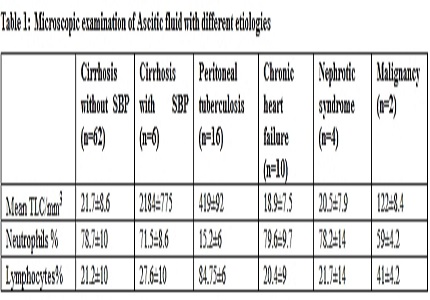Clinical profile and comparison of SAAG with ascites fluid total protein (AFTP) in cases of ascites at a tertiary referral hospital in Maharashtra
Abstract
Aims: This observational prospective study was carried out with aims of 1) study various presentations and clinical features in ascites cases, 2) assess different etiological factors, 3) compare serum ascitic albumin gradient (SAAG) and ascitic fluid total protein (AFTP) in differentiating portal hypertension related causes of ascites from others, 4) study in hospital outcome in cases of ascites.
Material and Methods: 100 consecutive ascites cases admitted in wards with clinical diagnosis and sonographic confirmation were recruited in the study. After history and detailed clinical examination cases were subjected to ultrasonography and portal vein Doppler to diagnose portal hypertension which was followed by paracentesis. Serum Albumin & total protein, ascitic fluid albumin and total protein, AFTP and SAAG was determined.
Results: Mean age of diagnosis of ascites was 42.41 ±7.72 years and maximum cases in 30-49 years age group. 68% of cases of ascites had cirrhosis of liver, 16% peritoneal (abdominal) tuberculosis, 10% chronic heart failure (CHF), 4% nephrotic syndrome and 2% had ovarian malignancy. Mean AFTP and Mean SAAG was 1.77±0.73gm% and 2.05±0.52 gm% in 78 cases of portal hypertension related ascites respectively. In normal portal pressure cases (n=22) of ascites it was 3.01±0.37 gm% and 0.72±0.19 gm% respectively. Sensitivity of AFTP and SAAG in differentiating portal hypertension related etiology from other causes was 70.51% and 92.31% respectively .Though sensitivity was less, specificity was equal ( 95.45%). Eight cases had variceal bleeding, 9 had hepatorenal syndrome and 15 had hepatic encephalopathy. Total 16 cases of liver cirrhosis with ascites died in hospital commonest cause was hepatic encephalopathy and hepatorenal syndrome.
Downloads
References
2. Runyon BA, Montano AA, Akriviadis EA, Antillon MR, Irving MA, McHutchison JG. The serum-ascites albumin gradient is superior to the exudate-transudate concept in the differential diagnosis of ascites. Ann Intern Med. 1992 Aug 1;117(3):215-20.
3. Pare P, Talbot J, Hoefs JC. Serum-ascites albumin concentration gradient : A physiologic approach to the differential diagnosis of ascites. Gastroenterology 1983;85: 240-4.
4. Goyal AK, Goyal SK, Pokharna DS, Sharma SK. Differential diagnosis of ascitic fluid : Evaluation and comparison of various biochemical criteria with a special reference to serum ascites albumin concentration gradient and its relation to portal pressure. Tropical Gastroenterology 1989; 10 (1): 512-55.
5. Rector WG Jr, Reynolds TB. Superiority of the serum-ascites albumin difference over the ascites total protein concentration in separation of "transudative" and "exudative" ascites. Am J Med. 1984 Jul;77(1):83-5. [PubMed]
6. Khan FY. Ascites in the state of Qatar: aetiology and diagnostic value of ascitic fluid analysis. Singapore Med J. 2007 May;48(5):434-9. [PubMed]
7. Hafiz Muhammed Aslam, Shafaq Saleem, Epidemiology and symptomatology of exudative and transudative type of ascites in hospitalized patients. Pakistan Journal of Pharmacology 2012; 29(2): 1-6.
8. Chow KM, Ying Chow VC, Tsui Hung LC, Man Wong S, and Chun Szeto C, Tuberculous Peritonitis–Associated Mortality Is High among Patients Waiting for the Results of Mycobacterial Cultures of Ascitic Fluid Samples Clinical Infectious Diseases 2002; 35:409–13.
9. Sanai FM, Bzeizi KI; Systematic review: tuberculous peritonitis--presenting features, diagnostic strategies and treatment. Aliment Pharmacol Ther. 2005 ; 22(8):685-700.
10. Adhikari P, Pathak UN, Uprety D, Sapkota S. Profile of ascites patient admitted in Nepal Medical College Teaching Hospital. Nepal Med Coll J. 2012 Jun;14(2):111-3.
11. M Beg, S Husain, N Ahmad, N Akhtar Serum/Ascites Albumin Gradient in Differential Diagnosis of Ascites Journal, Indian Academy of Clinical Medicine ,2001 ; (2):51-54.
12. Ali Saqiib, Rizwan Rasull Khan, Zahid Masoo, Irshad ull Haque, The frequency of Spontaneous Bacterial Peritonitis (SBP) in cirrhotic patients with ascites due to hepatitis C and B viruses. JUMDC 2012; 3(1) : 22-26.
13. Malabu UH, Olubuyide IO, Shaibu ME, Olawuyi F, Ascites in Ibadan, Nigeria- usefulness of albumin gradient in its etiologic diagnosis. Biomedical Research. 2006; 17 (2): 105-109.
14. Blake J, Berman P. The use of adenosine deaminase assays in the diagnosis of tuberculosis. S Afr Med J. 1982 Jul 3;62(1):19-21. [PubMed]
15. Agarwal Shashikant, Shrivastava Asha. Adenosine deaminase (ADA) activity in the diagnosis of tuberculous ascites. Journal of Advance Researches in Biological Sciences; 2010, 3 (1): 61-65. [PubMed]
16. Maskey R, Karki P, Ahmed SV, Manandhar DN. Clinical profile of patients with cirrhosis of liver in a tertiary care hospital, Dharan, Nepal. Nepal Med Coll J. 2011 Jun;13(2):115-8. [PubMed]
17. Sarin SK, Chari S, Sundaram KR, Ahuja RK, Anand BS, Broor SL. Young v adult cirrhotics: a prospective, comparative analysis of the clinical profile, natural course and survival. Gut. 1988 Jan;29(1):101-7.



 OAI - Open Archives Initiative
OAI - Open Archives Initiative


